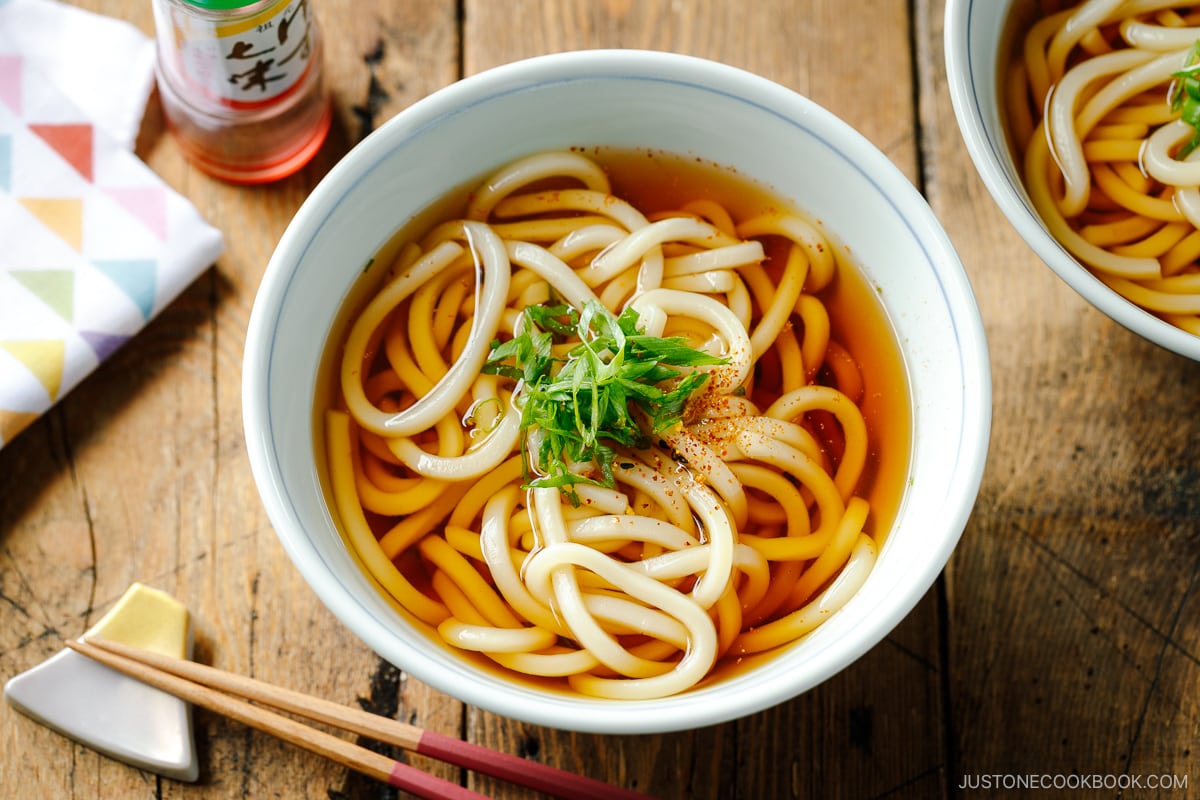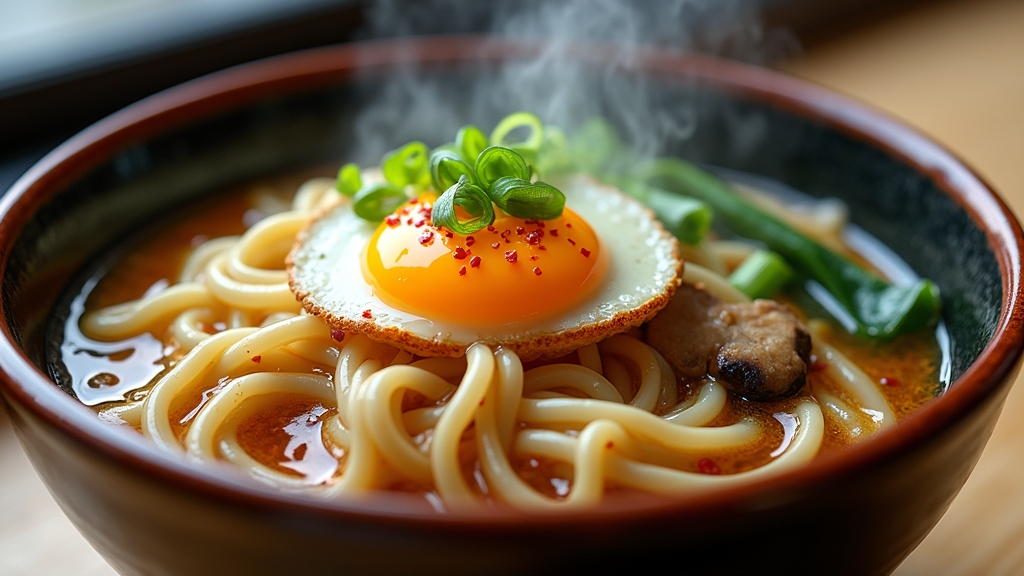If you’re craving something warm and comforting, udon noodle soup is the perfect choice! I love the thick, chewy noodles paired with a savory broth made from dashi, soy sauce, and mirin. Just add some fresh veggies like bok choy and shiitake mushrooms for an extra burst of flavor. Top it off with green onions, and you’ve got a satisfying meal. Stick around, and you’ll discover more tips to elevate your udon noodle experience!
History
Udon noodles have a fascinating history that stretches back centuries, enchanting taste buds along the way. Originating in Japan during the Heian period, these thick, chewy noodles were initially crafted for the nobility, showcasing their cultural significance within Japanese cuisine. As I explore deeper into their past, it’s clear that udon reflects the evolution of Japanese culinary practices—adapting regional influences and ingredients over time. They symbolize communal dining, often enjoyed in family gatherings or local festivals. Today, udon’s versatility shines in modern kitchens, blending tradition with innovation. I find it exciting how this humble noodle continues to inspire chefs and home cooks alike, bridging generations while remaining a beloved staple in our culinary landscape.
Recipe
Udon noodle soup is a comforting Japanese dish that features thick, chewy udon noodles in a savory broth, often topped with a variety of fresh ingredients. The simplicity of this dish allows the flavors of the broth and toppings to shine, making it a favorite among many. Whether enjoyed on a chilly day or as a quick weeknight meal, udon noodle soup is both satisfying and nourishing.
This recipe will guide you through creating a delicious bowl of udon noodle soup from scratch. The key to a great udon soup lies in the broth, which can be made from scratch or enhanced with store-bought dashi. The toppings are versatile, so feel free to customize them with your favorite vegetables and proteins. Let’s get started!
Ingredients:
- 200g udon noodles
- 4 cups dashi broth (or vegetable/chicken broth)
- 2 tablespoons soy sauce
- 1 tablespoon mirin
- 1 teaspoon sesame oil
- 1 cup sliced shiitake mushrooms
- 1 cup bok choy, chopped
- 1 carrot, julienned
- 2 green onions, sliced
- Optional: soft-boiled egg, tofu, or tempura for topping
Cooking Instructions:
Begin by cooking the udon noodles according to the package instructions, then drain and set aside. In a large pot, combine the dashi broth, soy sauce, mirin, and sesame oil, and bring it to a simmer over medium heat. Add the sliced shiitake mushrooms, bok choy, and carrots to the broth, cooking for about 5-7 minutes until the vegetables are tender. Finally, add the cooked udon noodles to the pot and let everything heat through for an additional 2 minutes before serving.
Extra Tips:
To elevate the flavor of your udon noodle soup, consider using homemade dashi from kombu and bonito flakes for a rich umami taste. Don’t hesitate to experiment with various toppings such as sliced grilled chicken, shrimp, or a sprinkle of nori for added texture and flavor. If you’re looking for a vegetarian option, simply swap out the dashi for a vegetable broth and include extra veggies for a hearty meal. Enjoy your homemade udon noodle soup!
Cooking Steps
Now that we’ve gathered our ingredients, let’s get into the cooking steps that will transform them into a delicious udon noodle soup. I’ll guide you through preparing the broth, adding vibrant vegetables, and perfectly cooking the udon noodles. Each step builds flavor, so let’s make this bowl of comfort come to life!
Step 1. Prepare Broth Ingredients
To create a rich and flavorful broth for your udon noodle soup, I recommend gathering five essential ingredients that will elevate the dish. These components not only vary in broth types but also enhance the overall flavor profiles of your soup. Here’s what you’ll need:
- Dashi – This Japanese stock forms the backbone of your broth, offering umami depth.
- Soy Sauce – Adds a savory saltiness that brings balance to the flavors.
- Mirin – A sweet rice wine that introduces a subtle sweetness, rounding out the taste.
- Sesame Oil – Just a dash will impart a nutty aroma that tantalizes the senses.
With these ingredients, you’ll be well on your way to crafting a delicious udon soup!
Step 2. Add Vegetables to Broth
As the broth simmers gently, I love to add a vibrant medley of vegetables that not only enhance the flavor but also bring a beautiful array of colors to the dish. I usually start with classic vegetable varieties like bok choy and shiitake mushrooms, which infuse the broth with umami richness. Then, I toss in thinly sliced carrots and bell peppers for a sweet crunch. Adding snap peas not only provides a delightful texture but also a pop of freshness. Each vegetable contributes to the overall broth enhancement, creating a harmonious balance. I let them simmer just until tender, allowing their flavors to meld beautifully. This colorful combination not only elevates the dish visually but also transforms it into a nourishing experience.
Step 3. Add Udon Noodles
Once the vegetables have softened and the broth is bursting with flavor, it’s time to introduce the star of the show: udon noodles. I love the way these thick, chewy noodles transform the dish into a comforting masterpiece. Here’s how I add them:
- Choose Your Udon Varieties: Fresh, frozen, or dry—each brings a unique texture and flavor.
- Boil Separately (if needed): For dry udon, I boil them separately to guarantee perfect noodle textures.
- Add to Broth: Gently stir in the noodles, letting them absorb the rich flavors.
- Simmer Briefly: I let them simmer for just a few minutes, ensuring they’re heated through without losing that delightful chew.
Now, we’re one step closer to an incredible bowl of udon noodle soup!
Step 4. Season the Broth to Taste
While the udon noodles are soaking up the flavors of the broth, I turn my attention to seasoning, ensuring every spoonful is packed with deliciousness. First, I taste the broth, letting its warmth wash over my palate. I might start with a splash of soy sauce for umami depth or a sprinkle of salt to enhance its natural broth flavors. If I’m feeling adventurous, I add a dash of sesame oil for richness or a hint of chili oil for heat. Don’t forget the magic of mirin or rice vinegar, which can elevate the dish’s complexity. Remember, the key is to balance the flavors, so adjust little by little—tasting as I go, creating a symphony of savory goodness!
Step 5. Garnish With Green Onions
To finish off the udon noodle soup, I love to garnish it with a handful of vibrant green onions. Their crisp texture and fresh flavor are a perfect complement to the rich broth. Here’s how I do it:
- Slice the green onions: I finely chop both the green and white parts for a colorful presentation.
- Sprinkle generously: A light dusting over the soup not only looks appealing but also enhances the flavor.
- Add at the last minute: I wait until just before serving to keep their crunch intact.
- Experiment with variations: Sometimes, I mix in a little sesame oil for an extra layer of flavor enhancement.
These simple steps truly elevate my udon noodle experience!
Nutritional Guide
Nutritional balance is key when enjoying a comforting bowl of udon noodle soup. I love how this dish can be both nourishing and satisfying, offering various nutritional benefits.
Here’s a quick look at the nutritional components:
| Nutrient | Amount per Serving |
|---|---|
| Calories | 300 |
| Protein | 10g |
| Fiber | 4g |
When crafting your udon noodle soup, consider dietary considerations like gluten sensitivity or protein sources. You can easily customize the soup by adding tofu, vegetables, or lean meats. This way, you’re not only enhancing the flavor but also boosting the nutritional profile. Enjoying a bowl of udon can be a delicious way to meet your dietary needs while indulging in an innovative culinary experience.
Final Thoughts
As I reflect on the delightful experience of savoring udon noodle soup, I’m reminded of how this dish effortlessly combines comfort and nourishment. Its cultural significance runs deep, often bringing families together over shared bowls. Here are some serving suggestions to elevate your udon experience:
Savoring udon noodle soup brings warmth and togetherness, making it a cherished dish that nourishes both body and soul.
- Garnish with fresh herbs like cilantro or green onions for an aromatic twist.
- Add protein such as tofu, shrimp, or chicken to enhance the dish’s heartiness.
- Incorporate seasonal vegetables like bok choy or mushrooms for added texture.
- Experiment with broth bases, using miso or dashi, to explore diverse flavor profiles.
Frequently Asked Questions
Can I Use Other Types of Noodles Instead of Udon?
I’ve swapped udon for rice noodles, soba noodles, or egg noodles in my dishes. Even instant ramen or whole wheat noodles work great. For a gluten-free option, try gluten-free noodles—deliciously innovative alternatives!
What Variations Can I Make for a Vegetarian Udon Soup?
When I make a vegetarian udon soup, I love using rich vegetable broth and exploring protein options like tofu or tempeh. Adding vibrant vegetables and spices really elevates the flavors, creating a delightful, innovative dish!
How Do I Store Leftover Udon Noodle Soup?
I love storing leftover soup! I use airtight soup containers for ideal freshness. Just let it cool, pour it in, label it, and pop it in the fridge. These storage tips keep everything delicious for later!
What Are Common Toppings for Udon Noodle Soup?
When crafting a bowl of warmth, think of toppings as the finishing brushstrokes. I’ve enjoyed popular garnishes like scallions, tempura, and nori. Exploring unique topping ideas can elevate your soup into a culinary masterpiece!
Can I Freeze Udon Noodle Soup for Later Use?
Absolutely, I freeze my soups using smart freezing techniques. It preserves their flavors and boosts soup longevity. Just make certain you cool it completely and use airtight containers. This way, you’ll enjoy it later without compromising taste!
Conclusion
So, you might think making udon soup is too complicated, but trust me, it’s easier than it sounds! Picture yourself stirring that rich, savory broth, the aroma filling your kitchen as the noodles soften to perfection. Each bowl is a warm hug on a chilly day, inviting you to slow down and savor every bite. With just a few simple ingredients and steps, you can create a comforting dish that warms both your heart and your belly.

Udon Noodle Recipe Soup
Ingredients
Equipment
Method
- In a large pot, heat sesame oil over medium heat. Add minced garlic and grated ginger, sauté for 1 minute until fragrant.
- Pour in the broth and dashi stock (if using). Stir in soy sauce and mirin. Simmer for 10 minutes.
- In a separate pot, boil water and cook udon noodles according to package instructions (usually 8-10 mins for dried, 2-3 mins for fresh). Drain and rinse under cold water.
- Add shiitake mushrooms to the broth and cook for 3-4 minutes.
- Stir in baby spinach and tofu (if using) until wilted (about 1-2 minutes).
- Divide cooked udon noodles into bowls. Ladle the hot broth and vegetables over the noodles.
- Top with green onions, soft-boiled eggs, and a drizzle of chili oil (optional).
- Enjoy hot with chopsticks and a spoon!
Notes
- Vegetarian Option: Use vegetable broth and skip dashi or use kombu dashi.
- Protein Variations: Add sliced chicken, shrimp, or tempeh.
- Storage: Broth and noodles should be stored separately; reheat gently.

